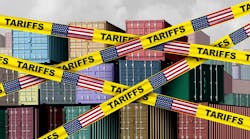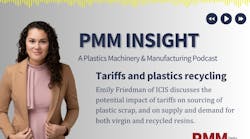Prepare now for potential tariff shocks
By Bruce Geiselman and Karen Hanna
Stay calm, talk it out and study on.
That’s some of the advice from some manufacturing leaders who spent Monday watching as President Trump announced, then paused, tariffs on Mexico and Canada, while imposing new levies on China. Whether you make plastic parts or molds or tooling, you’d better know your supply chain up and down, consultants Jan Griffiths and Laurie Harbour said.
As she monitored the news Monday, automotive supply chain expert Griffiths cautioned manufacturers against making decisions based on moment-to-moment developments.
“We cannot run a business, an industry, based on an immediate reaction to something like this. So, my first point is stay calm. ... Keep an eye to the long-term view, as well as dealing with this short-term disruption,” said Griffiths, who as the founder of Gravitas Detroit works with Tier 1 suppliers in the automotive industry.
While possible tariffs against Mexico and Canada were put on hold, China announced Tuesday its own surcharge package in retaliation for the U.S. imposition of additional 10 percent tariffs on its products.
Monday’s tumultuous flurry of trade-related announcements roiled the markets, but for Griffiths and Harbour, the news underscored how critical it is for manufacturers to examine their supply chains and maintain communications with their suppliers and customers.
“Know your supply chain. Know where your resins are coming from, any component parts that you might need, obviously, tool and dies,” said Griffiths, the host of the Automotive Leaders Podcast who on Monday relaunched the “Auto Supply Chain Prophets” podcast in partnership with the Automotive Industry Action Group (AIAG) and supply chain software maker QAD. The AIAG offers resources to navigate tariff changes.
Time to develop a plan
The one-month pause in the tariffs against Canada and Mexico gives manufacturers a bit of a breather to develop contingencies, said Harbour, who recalled that just recently she heard people chuckling at the idea the U.S. might hit Canada with tariffs.
That suggests they have some homework to do.
“Study the lobbyists, the people who are on the [Capitol] Hill that know this data, understand the implications, because it will affect you even if it's further away from what you feel is a direct effect, and you just need to understand it and plan for it. ... Remain flexible in your business, manage your demand and your supply,” said Harbour, a partner at Wipfli LLP and longtime consultant to molding and mold making shops. “Don’t overbuild ... [do] those things that allow you to be a flexible company, to react if all of a sudden someone calls and says, ‘I need less product,’ or, ‘Hey, I can't get stuff out of Mexico,’ or, ‘Hey, by the way, you’ve got to pay a 25 percent tariff.’ How will you react?”
Harbour also encouraged companies to get involved with the trade groups, such as the Plastics Industry Association (PLASTICS), American Mold Builders Association and MEMA: The Vehicle Suppliers Association, that represent their interests.
But she cautioned using the one-month reprieve from tariffs to stock up on inventory, in anticipation that the U.S. might levy charges on imports from Mexico and Canada, is a risky business.
“I’m sure that lots of companies, including the big OEMs, are going to do some pre-ordering and pre- buying of stuff out of Mexico in the next month to cover themselves for the future. I get nervous about that because I’ve got to be able to sell that someday. ... I’m going to tie up a lot of cash on my books doing that,” Harbour said.
Contact your customers
To ready themselves for whatever tariffs might be around the corner, Griffiths advised that manufacturers need to be talking with the customers.
If there are tariffs, she said they need to be ready to negotiate over who will bear the cost — but manufacturers shouldn’t lead with their demands.
“Open the dialogue,” she said. “Open the discussion with your customer about how these tariffs are going to be handled. ... If you wait, you’re going to be the last in line."
In studying their supply chains, companies should look at products that move across borders multiple times, and identify vulnerabilities.
Brokers and customs experts can help manufacturers with classification and origin engineering, to ensure they’re paying the appropriate tariff and that the country of origin listed for their products is favorable.
“Develop your contingency plans for your highest-risk product in terms of the tariff impact, and then you have to make a decision as a business whether or not you’re going to execute those plans, but keep in mind, you’ve got to have a long-term view. And it’s very difficult right now because things are changing so rapidly,” Griffiths said.
Look for new opportunities
For some manufacturers, including mold makers, tariffs might open a window for new business, she said.
“This is an opportunity for plastic injection molders that have their own tool and die shop in house,” she said.
Expanding to new markets is one mitigation strategy.
That’s something John McCormick, president of Mississauga, Ontario-based Proco Machinery Inc., pledged to do as he reacted to the news Monday. As the consultants recommended that other manufacturers do, he said he’s already working to make his company more competitive.
He said he is examining how the company can make automation equipment that costs less than what is offered by U.S. competitors, thus offsetting the impact of any tariffs, and he’s looking at expanding sales in Canada, where he wouldn’t have to worry about tariffs. In addition, he is looking to expand sales in Mexico and investigating expansion into other markets.
“We’ve shipped to Saudi Arabia and Australia. The world is our oyster, so to speak,” he said.
Knowing their markets and keeping in mind contingencies for what might happen next can help manufacturers weather whatever disruptions might await, according to Griffiths.
“I would run a whole bunch of what-if scenarios, knowing that the stress points right now are immediately Mexico, Canada, China right behind that, and right behind that is Europe because they’re already making noises about Europe,” she said.
Related content
About the Author
Karen Hanna
Senior Staff Reporter
Senior Staff Reporter Karen Hanna covers injection molding, molds and tooling, processors, workforce and other topics, and writes features including In Other Words and Problem Solved for Plastics Machinery & Manufacturing, Plastics Recycling and The Journal of Blow Molding. She has more than 15 years of experience in daily and magazine journalism.
Bruce Geiselman
Senior Staff Reporter Bruce Geiselman covers extrusion, blow molding, additive manufacturing, automation and end markets including automotive and packaging. He also writes features, including In Other Words and Problem Solved, for Plastics Machinery & Manufacturing, Plastics Recycling and The Journal of Blow Molding. He has extensive experience in daily and magazine journalism.



